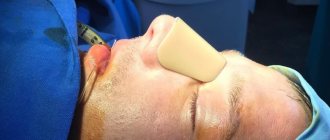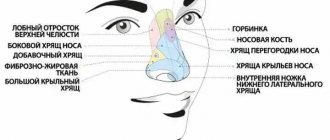Listen to the opinion of a specialist
In fact, rhinoplasty is rarely used as an operation to correct physical defects. It is practiced, for example, for congenital defects of the external nose, various injuries and damage. There are no questions here - this is a 100% indication for surgical intervention, because the quality of life suffers. In this case, nasal breathing may not be impaired, but it is impossible to live with the defect. And here the surgeon must make every effort to solve the person’s problem.
But in practice, an operation such as rhinoplasty is mainly used to obtain some kind of aesthetics - when a person goes from good to better. Usually they resort to it when people want attention, some changes and believe that changing the nose will lead to an improvement in life. And I must say, such an opinion has a right to life, because the nose is the most prominent part of the face, on which the eye initially falls when looking at the face. And if the nose is beautiful and aesthetic, it creates a favorable impression.
Article on the topic
Mortal risk. Mistakes we make when caring for our nose When changing the shape of the nose, they often copy a famous person. For example, we like a famous Hollywood star, and we decide to try on ourselves at least partially in her image. However, not everyone understands that sometimes it is technically impossible to do what you want. Like a hairstyle - for example, I have straight hair, but I want curly, but this cannot be done forever, only with a short-term effect at best. Thus, it is difficult to correct the nose if there is a deficiency of tissue - cartilage, bone, skin, etc. Then the risks of thinning the nose even further and making it sharp increase. However, it happens that when a person hears from a surgeon that in such a situation it is better not to experiment, he psychologically perceives this as a lack of qualifications of a doctor and goes to look for another. As a result of a long search, he finds and gets a rather unexpected result.
Here it is important to understand that these operations are paid, so a doctor who has the necessary knowledge and skills will not refuse them just because he doesn’t want to. Doctors rarely deceive and make a deal with their conscience. Therefore, to avoid disappointment as a result, you should collect at least three opinions from competent and recognized doctors to assess your prospects. Then you won't have to be disappointed.
How long does nasal swelling last after rhinoplasty?
Experts say that the defect will completely disappear in about a year to a year and a half after surgery. The duration depends on the physiology of each organism.
It turns out that swelling after rhinoplasty plays a positive role in the regenerative process. As a result of this phenomenon, cell division accelerates. And as soon as the blood supply begins to be restored, the swelling and swelling from the face goes away.
We recommend additional reading: How to quickly and effectively relieve facial swelling at home
The timing of swelling after rhinoplasty is influenced by the following factors:
- age criteria;
- the body’s tendency to metabolism, physiological edema;
- elasticity of the epidermis;
- complexity of the operation.
With the disappearance of the defect, the risk of infection decreases and damaged capillaries are restored.
Who should have the surgery
There is also a subtle nuance - who should perform the operation: an ENT surgeon or a plastic surgeon. In my opinion, such an intervention should be performed by an ENT surgeon who is certified and experienced as a plastic surgeon. Such a specialist does not work throughout the body, he is only occupied in the zygomatic-orbital area: the external nose, cheeks. Because it is important not only to correct the outside of the nose, but also not to forget about proper nasal breathing.
Liposuction and rhinoplasty. How did aesthetic surgery develop? More details
Swelling after rhinoplasty by month
The severity of the swelling gradually changes. Doctors divide this process into primary, secondary and residual stages. After a certain period of time, the defect disappears and the operated area takes on a healthy appearance. Therefore, surgeons consider the presence of edema to be a normal process.
Primary edema
The first swelling occurs during rhinoplasty. The most severe swelling is especially noticeable in the first day, after which it gradually subsides. To minimize this process, plastic surgeons fix the nose with a plaster splint. The plaster helps keep the corrective area in the desired position. But this can cause swelling to spread to other areas of the face. The lower eyelids, cheeks, forehead, and sometimes the chin may be affected.
Local administration of medications effectively facilitates postoperative adaptation.
In the first month of rehabilitation after rhinoplasty, it is recommended:
- sleep only on your back;
- do not tilt your head down.
- limit physical activity;
- avoid potential injury;
- do not drink alcohol;
- wash your face carefully.
You cannot use hot and cold compresses on your own to remove the defect. After 30 days, the primary swelling will subside on its own, leaving barely noticeable lumps.
Secondary edema
After removing the plaster, the swelling of the nose, although less pronounced, brings more discomfort. The swelling, which can persist for about a month, prevents the patient from breathing. The soft tissues and mucous membranes are still in an inflamed state. You can make breathing easier after rhinoplasty with the help of special medications.
In this state, a person experiences:
- headaches;
- constant fatigue;
- lack of sleep;
- decreased immunity.
To alleviate the condition, relieve swelling and speed up the recovery of the body, specialists prescribe multivitamins and immunomodulators.
Residual
A hardened tip of the nose indicates internal residual swelling after rhinoplasty. Visually, the face looks completely normal.
At the last stage of rehabilitation, blood supply is gradually restored. Depending on the damage to tissues and blood vessels, swelling can last approximately 12-18 months.
The density of the patient’s skin plays a big role in the speed of the recovery process. The thicker the skin, the longer it takes for the swelling to go away.
Complications
The nose has a frame structure. When we look at it, we often identify it with the roof of a house. So, both of them have a ramp. And if you make a mistake during the operation, you can break the frame. The nose may collapse, become dislodged, or even collapse. In the case of surgery, the nasal septum cannot withstand the operation because it has been greatly thinned. The plastic surgeon does not look into the nasal cavity, he usually looks from above. He understands that the nose must become different, more elegant - the task is clear. And he will not be distracted by looking at the nasal cavity, but will watch until the postoperative swelling subsides. An ENT surgeon monitors the condition inside.
After all, synechiae and adhesions can form inside the nasal cavity, which does not allow the nose to breathe fully later. And if synechiae begin to form, they can then haunt a person throughout his life.
Question answer
Why is it dangerous to sneeze with your mouth and nose closed? It is important to understand that surgery on the external nose, as well as on the nasal septum, is usually irreversible in most cases. Correcting someone is called reoperation. Because the mucous membrane and skin are all peeled off one by one, the nose is disassembled, including the septum, then the correct shape is given, the mucous membrane is sutured, tamponed (special tampons are put in, which create a frame from the inside), a plaster bandage is applied on top so that the person does not touch it fingers so that everything doesn’t slide to the side when he goes to bed. The plaster hardens and gives the desired frame, everything grows together, and that’s it - it will be difficult to fix anything. And it’s impossible to make it so that this year I want a nose like Angelina Jolie’s, and next year like Britney Spears’. This story can lead to sad consequences, like, for example, Michael Jackson.
Among the external complications are the remaining scars - instead of a cosmetic scar, a large keloid, dents, creases, wrinkles. Here you can correct it with injection cosmetology or reoperation, when an implant is placed from cartilage or special medical plastic, which the body will accept normally.
A problem can develop inside when the nose becomes narrowed and a person cannot breathe normally. And there is also the problem of the valve effect. When we sharply inhale air, the wings of the nose are pulled towards the septum. And during the operation, the wings can become so thin that they become excessively mobile. A person even has to hold them while inhaling like that.
Artificial beauty. How Indian executioners mastered rhinoplasty Read more
How to relieve swelling after rhinoplasty
Sometimes nasal swelling after rhinoplasty creates swelling of the entire face. Certain medications can help return the patient to a normal lifestyle.
We recommend further reading Redness around the eyes
Preparations for rapid tissue healing after rhinoplasty
Only a doctor can prescribe medications. It is based on factors such as a tendency to an allergic reaction and the individual characteristics of the patient.
Traumeel C ointments and tablets
The pharmaceutical market offers a homeopathic drug for rapid regeneration and relieving swelling. Traumeel S has a wide spectrum of action with a pronounced anti-inflammatory effect.
He is appointed:
- to accelerate regeneration;
- removal of small subcutaneous hematomas;
- obstacles to scar formation.
The product helps you quickly return to normal physical activity.
Bromelain
The product is a proteolytic enzyme of natural origin. Doctors recommend starting to take the drug before the operation. It has excellent anti-inflammatory and decongestant functions.
Dimexide
The active component of the drug has anti-inflammatory, antimicrobial and anesthetic effects. The drug is used for external use. Available in different pharmacological forms. Improves the course of metabolic processes in the area of inflammation.
Some drugs not only enhance the activity of other drugs, but also their toxicity. Therefore, they should be taken with caution and after consulting a doctor.
Physiotherapy to relieve swelling after rhinoplasty
For a speedy recovery, doctors recommend physiotherapeutic measures. Their main task is to improve blood circulation, metabolic processes in cells and reduce swelling at the tip of the nose.
Microcurrents
Microcurrent therapy is prescribed to improve blood circulation and restore sensitivity. During rhinoplasty, tissues are displaced and the functioning of nerve endings is disrupted.
The effect of the current strengthens the walls of blood vessels, relieves swelling, and quickly eliminates bruises at the cellular level. Therapy restores normal innervation.
Ultraphonophoresis
The administration of medications through the skin helps to consolidate the results after rhinoplasty.
Aspects of ultrasound have a gentle effect on the body:
- stimulate the formation of young cells;
- relieve pain;
- reduce irritability;
- enhance cellular metabolism;
- promote a sterilizing effect.
The effect of the procedure is quite strong, since the beneficial substances penetrate deep into the skin.
Traditional methods
If the tissues are swollen and swelling of the tip of the nose is bothersome after rhinoplasty, then the patient can try some alternative medicine recipes in combination with drug treatment.
Take an aloe leaf and cut it lengthwise. If you apply the cut to the swelling, it will go away faster.
It is effective to use herbal compresses for swelling, such as string and chamomile. To do this, prepare a herbal decoction, soak a piece of bandage in it and apply it to the worried area. Keep for about 20 minutes. Then repeat the manipulation daily for a week.
We recommend further reading Treatment of hematoma and swelling on the face after an impact
Teas made from ginger root or dried mountain medicinal arnica are useful for swelling. You need to drink twice a day.
Although decongestants are not permanent, they help make temporary discomfort easier to bear.
Alternative
If an ENT doctor or plastic surgeon says that the issue is difficult to resolve, then it is better not to interfere. Today, injection cosmetology is becoming an alternative. This story is controlled - the drug is injected, and it can then be removed - put the syringe in and pull the drug back out. Injection cosmetology removes dents well and straightens bumps. Yes, you have to do it periodically, but this interval is not once every two weeks or a month, but once every six months or a year. This measure eliminates the need for a scalpel and psychological trauma, and can always be adjusted along the way.
And it is also important to remember that such an operation cannot be cheap, since it is painstaking. For an ENT surgeon with the necessary qualifications, it is estimated at 300 thousand rubles. Accordingly, if they offer to do it for 18 or even 25 thousand rubles, it’s worth thinking about. After all, it is unlikely that everything will be returned to the way it was.
There are contraindications, you should consult your doctor









